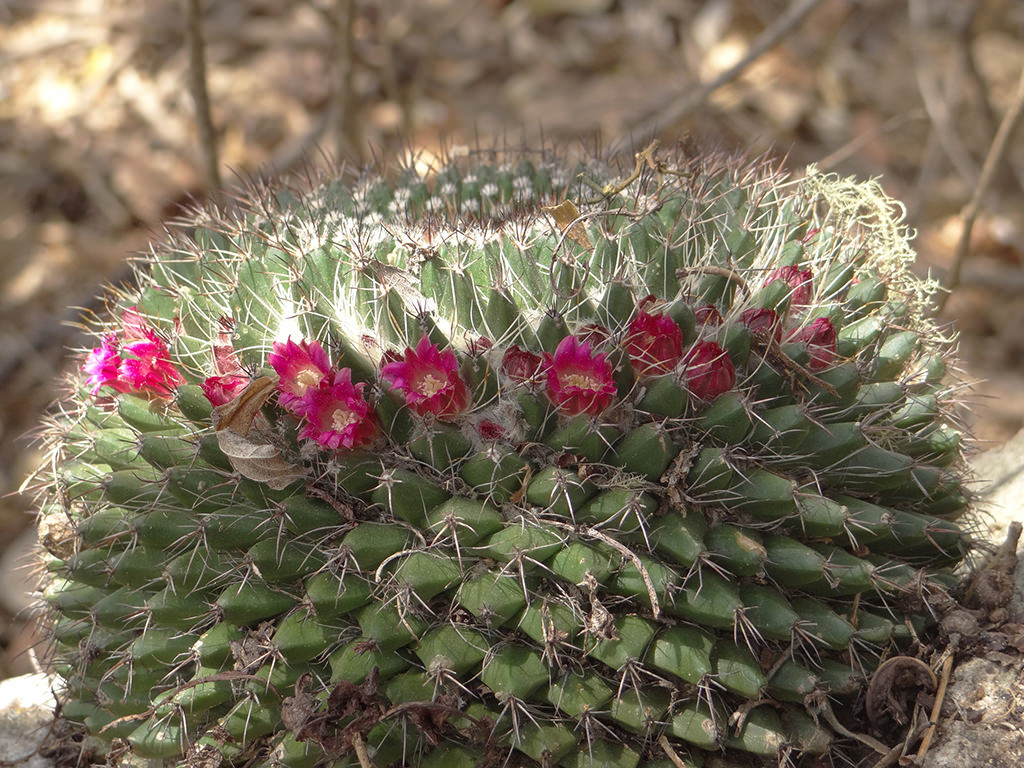Scientific Name
Mammillaria mystax Mart.
Synonym(s)
Mammillaria atroflorens, Mammillaria casoi, Mammillaria erythra, Mammillaria huajuapensis, Mammillaria mixtecensis, Neomammillaria mystax
Scientific Classification
Family: Cactaceae
Subfamily: Cactoideae
Tribe: Cacteae
Subtribe: Cactinae
Genus: Mammillaria
Origin
This species is native to Mexico, where it grows in highland regions in Guerrero, Oaxaca, and Puebla at elevations of 3,000 (915 m) to 8,500 feet (2,600 m).
Description
Mammillaria mystax is a cactus with a flat-topped, globose to short cylindrical, usually solitary stem with pyramid-shaped tubercles, white wool in the axils, and clusters of stout spines. The stem grows up to 6 inches (15 cm) tall and 4 inches (10 cm) in diameter. It can produce offsets to form loose clumps with age. Spines are mostly appressed and variable in length, sometimes reaching 2.8 inches (7 cm). It has 1 to 4 central and 3 to 10 radial spines per areole. The central spines are purplish with dark brown tips and usually up to 0.8 inches (2 cm) long, while the radial spines are white, often with darker tips and up to 0.3 inches (0.8 cm) long. Flowers are pink-purple with brownish midveins, up to 1 inch (2.5 cm) long, nearly equal in diameter, and appear in spring, forming a ring around the stem. Fruits are red, club-shaped, and up to 1 inch (2.5 cm) long.
Etymology
The specific epithet "mystax (MY-staks)" is a Latin noun meaning "mustache" and probably refers to the long twisted spines found on some specimens.

How to Grow and Care for Mammillaria mystax
Light: Plant this cactus in an area of your garden that receives 4 hours of direct sunlight a day. If you are growing M. mystax indoors, place it near the brightest window in your home or office to ensure your cactus gets enough light. If possible, place the pot on the balcony or in the garden for extra light from spring to fall.
Soil: M. mystax requires a soil mix that provides root aeration and good drainage, whether grown outdoors or indoors. Use commercial cactus potting mixes or create your own potting mix.
Hardiness: This cactus is heat tolerant but is not a cold-hardy plant. M. mystax can withstand temperatures as low as 20 to 50 °F (-6.7 to 10 °C), USDA hardiness zones 9a to 11b.
Watering: From spring to fall, water deeply and wait for the soil to dry out before watering again. Never let the pot sit in water. Suspend watering in the winter.
Fertilizing: M. mystax can benefit from fertilization during the growing season. Apply a water-soluble fertilizer for cacti and other succulents. Suspend feeding during the winter when the plant goes dormant.
Repotting: Repot every two or three years into a slightly larger pot. The best time to repot your M. mystax is late winter or early spring, but the repotting process can be done almost any time of the year.
Propagation: There are two easy ways to propagate M. mystax: by seeds or by dividing offsets. The best time to remove offsets is in spring and summer. Sow the seeds in late spring or summer.
Learn more at How to Grow and Care for Mammillaria.
Toxicity of Mammillaria mystax
M. mystax is considered non-toxic to both humans and pets.
Links
- Back to genus Mammillaria
- Succupedia: Browse succulents by Scientific Name, Common Name, Genus, Family, USDA Hardiness Zone, Origin, or cacti by Genus
Photo Gallery
Click on a photo to see a larger version.



